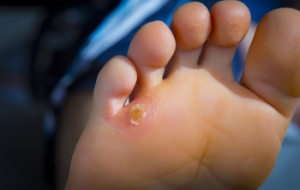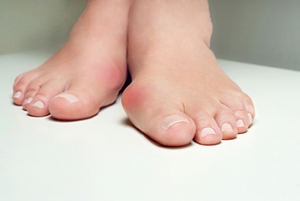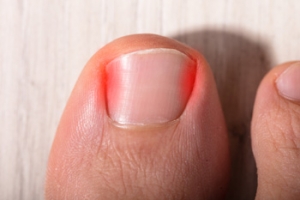
Dealing with Stress Fractures of the Foot and Ankle
Stress fractures are small breaks in the bone that are caused by repetitive stress. They typically occur due to overuse, forcing the bones of the foot or ankle to continually absorb the full impact of each step taken. Stress fractures can also be caused by abnormal foot structure, osteoporosis, bone deformities, or wearing improper footwear during exercise.
Stress fractures are common for individuals whose daily activities cause high levels of impact on their feet and ankles. Those who run, play tennis or basketball, or practice gymnastics tend to experience these fractures more frequently. Anyone is susceptible to this problem, though. Individuals who are normally sedentary and suddenly begin an intense, high impact workout may sustain stress fractures. This is because their muscles are not yet strong enough to handle and cushion the intensity of their activity. Osteoporosis may also cause someone to get stress fractures, because the disease weakens an afflicted person's bones and makes it easier for them to break down.
Pain from stress fractures typically occurs in the general area of the fracture. Pain can also manifest as “pinpoint pain” or pain that is felt when the site of the injury is touched, and can be accompanied by swelling. It may occur during or after activity, and it may disappear while resting and return when standing or moving. Engaging in any kind of activity, high impact or otherwise, will aggravate the pain. If the intensity of the activity increases before the stress fracture has properly healed, it can cause a full fracture.
Treatment can vary depending on the individual and the degree of injury. The primary way to treat a stress fracture is to rest the hurt foot. Some fractures will heal quickly with only a little bit of rest, while others may require a long rest period and the use of crutches, immobilization, or physical therapy. Under certain circumstances, surgery may be required to install support pins around the fracture to assist in healing.
If you are undergoing a new exercise regimen in running or some other kind of high impact activity, set incremental goals on a weekly basis so you can build up muscle strength. Make sure to wear supportive shoes to better protect you feet.
If you begin to experience any symptoms of stress fractures, you should stop exercising and rest. If the symptoms persist, consult with your podiatrist. Remembering these tips can help you prevent stress fractures to your foot and ankle, and allow you to continue living normally.
Ankle Foot Orthotics for Athletes
Ankle foot orthotics are shoe inserts that offer support to control the placement and movement of the ankle, correct deformities, and compensate for weakness. These inserts are used to stabilize the foot and ankle and provide toe clearance during the swing phase of gate.
Athletes often suffer foot problems because their feet are not being supported within the shoe. Ankle and foot orthotics are custom made inserts that alleviate stress on the foot. However custom orthotics should be prescribed by a podiatrist who specializes in customized footwear and orthotics design. These inserts are used by athletes for different reasons. Runners use orthotics to absorb shock at heel contact and to set up the forefoot for push-off. Basketball players wear them to control their forefeet while jumping and running.
The two main types of orthotics are over-the-counter orthotics and custom-made orthotics. To be eligible for custom orthotics, an examination of the foot and ankle will need to be completed. Afterward, both the foot and ankle will need to be casted and fitted for the proper orthotic. When the fitting process is complete, adjustments can be made to make sure everything fits perfectly.
Over the counter orthotics tend to be more popular than custom fit ones. Athletes who have less severe aches and pains in the foot, ankle or lower back area can use the over-the-counter version of orthotics. Unfortunately, over-the-counter orthotics tend to not work in treating severe injuries or ailments. Whenever you suspect you may need an ankle foot orthotic, you should consult with your podiatrist to determine which type of orthotic is right for you.
What Is Hyperkeratosis?
 Keratin is a tough, fibrous protein that is found in the skin. When the skin is exposed to excessive pressure, or is inflamed or irritated, the skin responds by producing extra layers of keratin to protect the damaged area. This is known as hyperkeratosis, and often happens to the skin on the soles of the feet and between the toes, creating calluses and corns. Calluses are areas of thickened skin that are typically uniform in their thickness. Corns are small, hard bumps that usually have a hard center with an outer ring of hardened tissue that is slightly softer than the center. Both calluses and corns can cause discomfort. If you have painful calluses, corns, or otherwise thickened, hardened skin on your feet, please consult with a podiatrist.
Keratin is a tough, fibrous protein that is found in the skin. When the skin is exposed to excessive pressure, or is inflamed or irritated, the skin responds by producing extra layers of keratin to protect the damaged area. This is known as hyperkeratosis, and often happens to the skin on the soles of the feet and between the toes, creating calluses and corns. Calluses are areas of thickened skin that are typically uniform in their thickness. Corns are small, hard bumps that usually have a hard center with an outer ring of hardened tissue that is slightly softer than the center. Both calluses and corns can cause discomfort. If you have painful calluses, corns, or otherwise thickened, hardened skin on your feet, please consult with a podiatrist.
Corns can make walking very painful and should be treated immediately. If you have questions regarding your feet and ankles, contact Jon McCreary, DPM of Fort Worth Podiatry. Our doctor will treat your foot and ankle needs.
Corns: What Are They? And How Do You Get Rid of Them?
Corns are thickened areas on the skin that can become painful. They are caused by excessive pressure and friction on the skin. Corns press into the deeper layers of the skin and are usually round in shape.
Ways to Prevent Corns
There are many ways to get rid of painful corns such as:
- Wearing properly fitting shoes that have been measured by a professional
- Wearing shoes that are not sharply pointed or have high heels
- Wearing only shoes that offer support
Treating Corns
Although most corns slowly disappear when the friction or pressure stops, this isn’t always the case. Consult with your podiatrist to determine the best treatment option for your case of corns.
If you have any questions please feel free to contact our office located in Fort Worth, TX . We offer the newest diagnostic and treatment technologies for all your foot and ankle needs.
Understanding Corns and Calluses
Corns and Calluses are both hardened layers of thickened skin that develop because of friction. Both ailments are typically found on the feet and may be unsightly. Although they have similarities, corns and calluses are different from each other.
Some causes of corns and calluses may be wearing ill-fitting shoes and not wearing socks. If you wear tight shoes, your feet will constantly be forced to rub against the shoes, causing friction. If you fail to wear socks, you are also causing your feet to endure excess friction.
There are some signs that may help you determine whether you have one of these two conditions. The first symptom is a thick, rough area of skin. Another common symptom is a hardened, raised bump on the foot. You may also experience tenderness or pain under the skin in addition to flaky, dry, or waxy skin.
There are also risk factors that may make someone more prone to developing corns and calluses. If you are already dealing with bunions or hammertoe, you may be more vulnerable to having corns and calluses as well. Other risk factors are foot deformities such as bone spurs, which can cause constant rubbing inside the shoe.
Corns tend to be smaller than calluses and they usually have a hard center surrounded by inflamed skin. They also tend to develop on the parts of the body that don’t bear as much weight such as the tops and sides of toes. Corns may also be painful for those who have them. On the other hand, calluses are rarely painful. These tend to develop on the bottom of the feet and may vary in size and shape.
Fortunately, most people only need treatment for corns and calluses if they are experiencing discomfort. At home treatments for corns and calluses should be avoided, because they will likely lead to infection. If you have either of these ailments it is advised that you consult with your podiatrist to determine the best treatment option for you.
Bunion Exercises
 A bunion is described as a bony protrusion that forms on the side of the big toe. Many patients experience pain and discomfort from this ailment, and it may gradually worsen. It can happen as a result of genetic factors, or from wearing shoes that do not have adequate room for the toes to move freely in. The muscles can become weakened, and it is beneficial to perform specific foot stretches that may help to strengthen the affected area and overall foot. A foot scrunch helps to improve dexterity when performed regularly. This is done by placing a towel on the floor, and lifting it up with your foot. Toe yoga helps to improve mobility in the toes, which may positively affect general balance in the body. If you have developed a bunion, it is strongly suggested that you speak with a podiatrist who can offer you additional exercise and treatment options that are right for you.
A bunion is described as a bony protrusion that forms on the side of the big toe. Many patients experience pain and discomfort from this ailment, and it may gradually worsen. It can happen as a result of genetic factors, or from wearing shoes that do not have adequate room for the toes to move freely in. The muscles can become weakened, and it is beneficial to perform specific foot stretches that may help to strengthen the affected area and overall foot. A foot scrunch helps to improve dexterity when performed regularly. This is done by placing a towel on the floor, and lifting it up with your foot. Toe yoga helps to improve mobility in the toes, which may positively affect general balance in the body. If you have developed a bunion, it is strongly suggested that you speak with a podiatrist who can offer you additional exercise and treatment options that are right for you.
If you are suffering from bunion pain, contact Jon McCreary, DPM of Fort Worth Podiatry. Our doctor can provide the care you need to keep you pain-free and on your feet.
What Is a Bunion?
Bunions are painful bony bumps that usually develop on the inside of the foot at the joint of the big toe. As the deformity increases over time, it may become painful to walk and wear shoes. Women are more likely to exacerbate existing bunions since they often wear tight, narrow shoes that shift their toes together. Bunion pain can be relieved by wearing wider shoes with enough room for the toes.
Causes
- Genetics – some people inherit feet that are more prone to bunion development
- Inflammatory Conditions - rheumatoid arthritis and polio may cause bunion development
Symptoms
- Redness and inflammation
- Pain and tenderness
- Callus or corns on the bump
- Restricted motion in the big toe
In order to diagnose your bunion, your podiatrist may ask about your medical history, symptoms, and general health. Your doctor might also order an x-ray to take a closer look at your feet. Nonsurgical treatment options include orthotics, padding, icing, changes in footwear, and medication. If nonsurgical treatments don’t alleviate your bunion pain, surgery may be necessary.
If you have any questions, please feel free to contact our office located in Fort Worth, TX . We offer the newest diagnostic and treatment technologies for all your foot care needs.
Bunions
A bunion is a bump that forms at the base of the big toe. Bunions form when the big toe pushes against the next toe, which forces the big toe joint to get bigger and stick out. As a result, the skin over the bunion may start to appear red and it may feel sore.
There are risk factors that can increase your chances of developing bunions. People who wear high heels or ill-fitting shoes are more likely to develop them, in addition to those who have a genetic history of bunions or have rheumatoid arthritis.
The most obvious way to tell if you have a bunion is to look for the big toe pushing up against the toe next to it. Bunions produce a large protrusion at the base of the big toe and may or may not cause pain. Other symptoms are redness, swelling, and restricted movement of the big toe if you have arthritis.
Nonsurgical methods are frequently used to treat bunions that aren’t severe. Some methods of nonsurgical treatment are orthotics, icing and resting the foot, taping the foot, and pain medication. Surgery is usually only required in extreme cases. However, if surgery is needed, some procedures may involve removing the swollen tissue from around the big toe joint, straightening the big toe by removing part of the bone, or joining the bones of your affected joint permanently.
Your podiatrist will diagnose your bunion by doing a thorough examination of your foot. He or she may also conduct an x-ray to determine the cause of the bunion and its severity.
Why Live with Pain and Numbness in Your Feet?
What Issues Do Podiatrists Treat?
 A podiatrist, also known as a doctor of podiatric medicine (DPM), is a doctor who specializes in the treatment of foot and ankle conditions. Podiatrists treat a variety of foot conditions for patients of all ages. Common issues that podiatrists diagnose and treat include ingrown toenails, blisters, warts, heel pain, foot pain, cracked skin, corns, nail infections, and foot injuries such as sprains or breaks. Many podiatrists also focus on specialized areas within foot medicine, and these specialties include surgery, wound care, sports medicine, diabetic foot care, and pediatric foot care. Podiatrists are also able to help patients who have underlying health conditions, such as obesity, diabetes, arthritis, and poor blood circulation, care for their feet. If you are struggling with pain, swelling, numbness, an open wound, or a possible infection surrounding the feet and ankles, consulting with a podiatrist for a proper diagnosis and treatment is recommended.
A podiatrist, also known as a doctor of podiatric medicine (DPM), is a doctor who specializes in the treatment of foot and ankle conditions. Podiatrists treat a variety of foot conditions for patients of all ages. Common issues that podiatrists diagnose and treat include ingrown toenails, blisters, warts, heel pain, foot pain, cracked skin, corns, nail infections, and foot injuries such as sprains or breaks. Many podiatrists also focus on specialized areas within foot medicine, and these specialties include surgery, wound care, sports medicine, diabetic foot care, and pediatric foot care. Podiatrists are also able to help patients who have underlying health conditions, such as obesity, diabetes, arthritis, and poor blood circulation, care for their feet. If you are struggling with pain, swelling, numbness, an open wound, or a possible infection surrounding the feet and ankles, consulting with a podiatrist for a proper diagnosis and treatment is recommended.
If you are experiencing pain in the feet or ankles, don’t join the stubborn majority refusing treatment. Feel free to contact Jon McCreary, DPM from Fort Worth Podiatry. Our doctor can provide the care you need to keep you pain-free and on your feet.
What Is a Podiatrist?
Someone would seek the care of a podiatrist if they have suffered a foot injury or have common foot ailments such as heal spurs, bunions, arch problems, deformities, ingrown toenails, corns, foot and ankle problems, etc.
Podiatric Treatment
A podiatrist will treat the problematic areas of the feet, ankle or lower leg by prescribing the following:
- Physical therapy
- Drugs
- Orthotic inserts or soles
- Surgery on lower extremity fractures
A common podiatric procedure a podiatrist will use is a scanner or force plate which will allow the podiatrist to know the designs of orthotics. Patients are then told to follow a series of tasks to complete the treatment. The computer will scan the foot a see which areas show weight distribution and pressure points. The podiatrist will read the analysis and then determine which treatment plans are available.
If you have any questions please feel free to contact our office located in Fort Worth, TX . We offer the newest diagnostic and treatment technologies for all your foot and ankle needs.
What is a Podiatrist?
The branch of medicine that is focused on the treatment, diagnosis, and study of disorders of the lower leg, ankle and foot is referred to as podiatry. Because people often spend a great deal of their time on their feet, many problems in this area can occur. A person seeks help from the field of podiatry when they need treatment for heel spurs, bunions, arch problems, deformities, ingrown toenails, corns, foot and ankle problems, infections, and problems with the foot that are related to diabetes and additional diseases.
To treat problems of the foot, ankle or lower leg, a podiatrist may prescribe physical therapy, drugs, perform surgery, or set fractures. Individuals may also be recommended to wear corrective shoe inserts, custom-made shoes, plaster casts and strappings in order to correct deformities.
When trying to gather information on a patient problem, a scanner or force plate may be used in order to design orthotics. During this procedure, patients are told to walk across a plate that is connected to a computer; the computer then takes a scan of the foot and indicates weight distribution and pressure points. The computer readouts will give the podiatrist information to help them determine the correct treatment plans.
Diagnosis is also provided through laboratory tests and x-rays. Through the foot, the first signs of serious problems such as heart disease, diabetes and arthritis can show up. For example, individuals that have diabetes may frequently have problems such as infections and foot ulcers because they experience poor circulation in the foot area. A podiatrist can then have consultations with patients when symptoms arise. Referrals will then be made to specialists that handle the greater health problems.
Some podiatrists have their own independent, private practices or clinics where they have a small staff and administrative personnel. Many podiatrists work within group practices. They usually spend time performing surgery in ambulatory surgical centers or hospitals, or visit patients in nursing homes. Podiatrists typically spend between 30 to 60 hours of week working. Some podiatrists specialize in public health, orthopedics, surgery, or primary care. Other fields include specialties in geriatrics, dermatology, pediatrics, diabetic foot care and sports medicine.
Some podiatrist specialists complete extra training in the area of foot and ankle reconstruction that results from the effects of physical trauma or diabetes. There are also surgeons that perform surgery of a cosmetic nature to correct bunions and hammertoes.
What Can Make Ingrown Toenails More Likely?
 An ingrown toenail occurs when the edges of the nail grow into the surrounding skin rather than over it. This can happen on any of the toes, but most frequently affects the big toe. Certain factors can make someone more likely to develop ingrown toenails. Wearing shoes that are too tight in the toe area can cause the toes to be compressed and can put excess pressure on the nail, pushing it against the skin. Trimming the toenails in a rounded shape or too short can also cause ingrown toenails. Excessive sweating in the feet can make the skin of the nail folds so soft that the nail easily pokes into it. Other factors that may make ingrown toenails more likely include a history of nail infections, having nail shape or structure abnormalities, and having a genetic predisposition to ingrown nails. For more information about how to care for your toenails and prevent ingrown nails, please consult with a podiatrist.
An ingrown toenail occurs when the edges of the nail grow into the surrounding skin rather than over it. This can happen on any of the toes, but most frequently affects the big toe. Certain factors can make someone more likely to develop ingrown toenails. Wearing shoes that are too tight in the toe area can cause the toes to be compressed and can put excess pressure on the nail, pushing it against the skin. Trimming the toenails in a rounded shape or too short can also cause ingrown toenails. Excessive sweating in the feet can make the skin of the nail folds so soft that the nail easily pokes into it. Other factors that may make ingrown toenails more likely include a history of nail infections, having nail shape or structure abnormalities, and having a genetic predisposition to ingrown nails. For more information about how to care for your toenails and prevent ingrown nails, please consult with a podiatrist.
Ingrown toenails can become painful if they are not treated properly. For more information about ingrown toenails, contact Jon McCreary, DPM of Fort Worth Podiatry. Our doctor can provide the care you need to keep you pain-free and on your feet.
Ingrown Toenails
Ingrown toenails occur when a toenail grows sideways into the bed of the nail, causing pain, swelling, and possibly infection.
Causes
- Bacterial infections
- Improper nail cutting such as cutting it too short or not straight across
- Trauma to the toe, such as stubbing, which causes the nail to grow back irregularly
- Ill-fitting shoes that bunch the toes too close together
- Genetic predisposition
Prevention
Because ingrown toenails are not something found outside of shoe-wearing cultures, going barefoot as often as possible will decrease the likeliness of developing ingrown toenails. Wearing proper fitting shoes and using proper cutting techniques will also help decrease your risk of developing ingrown toenails.
Treatment
Ingrown toenails are a very treatable foot condition. In minor cases, soaking the affected area in salt or antibacterial soaps will not only help with the ingrown nail itself, but also help prevent any infections from occurring. In more severe cases, surgery is an option. In either case, speaking to your podiatrist about this condition will help you get a better understanding of specific treatment options that are right for you.
If you have any questions please feel free to contact our office located in Fort Worth, TX . We offer the newest diagnostic and treatment technologies for all your foot and ankle needs.






